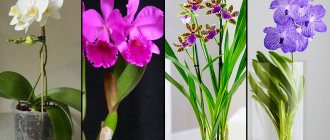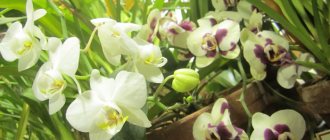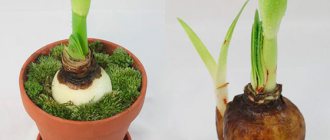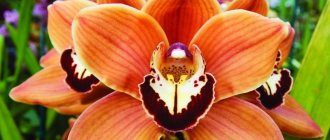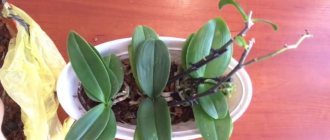Description and main characteristics of the device
There are many different lamps for lighting a flower. How to choose the right orchid?
Energy saving lamps (CFL)
- Their advantages over conventional incandescent lamps are obvious: They consume 4-5 times less energy. And the return is higher;
- Long warranty periods;
- Security is higher. Short circuits are very rare.
- Blue;
- Only 20% of the heat energy is spent on heat;
- MaxGrow;
Orchid lamps should not get hot.
Please note:
- The base size can be standard E27. and smaller – E14;
- Warm colors (closer to yellow) - below 4000 K. During flowering;
- Daylight – 4000-6440K. Universal;
- Cold tones (close to blue) – more than 6500 K. During the growing season.
Luminescent
- Gases (often mercury), thanks to the coating of lamps with phosphor, provide the presence of ultraviolet rays: LB (white color);
- LD (daytime color);
- LDC (daytime color with improved color rendering).
- Philips;
- T8 (diameter 26 mm);
Halogen
- Metal halide devices are also called gas discharge devices. These are almost the same as incandescent lamps for plants. But improved and more expensive;
- Their shapes and color spectrum are varied. But for plants (and orchids), purchase special models;
Many amateur gardeners use lighting for orchids.
- White and blue models: Sunmaster Leuchtmittel Wuchs 600 W;
- Greenbud MH: 250 W;
- 400 W;
- 600 W.
Mercury gas discharge
- The principle of their operation is the same as that of fluorescent ones;
- But the marking is different;
Mercury gas discharges operate on the same principle as fluorescent ones.
- You need a glow temperature from 3,200 to 4,200 K;
- There are also sodium gas discharge lamps. Low and high pressure.
LED
- LED lamps are in greatest demand among orchid lovers;
- What attracts: Cost-effectiveness;
- Long service life;
- Environmental Safety;
- Resistance to temperatures, mechanical stress;
- No UV radiation.
LED phytolamps.
Of all types, experts consider the following lamps to be the most effective for orchids:
- For flowering: Sylvania 250 W, HPS-TS 400W;
- Osram Nav-N 250W, 400W, 600 W, 1000 W;
- Philips Son T-plus 400 W, 600 W;
- Greenbud HPS 400 W, 600 W, 1000 W;
- GIB Lighting Flower Specter HPS 250 W, 400 W,600 W.
- Sylvania Growlux 400W, 600W;
LED strips
Now on Aliexpress you can order a 1 meter long LED strip with different combinations of blue and red LEDs for a few dollars. To remove heat, it can be glued to an aluminum threshold for linoleum joints. You will also need a 12 Volt power supply, which it is advisable to order with a current reserve of at least 0.4A.
For some reason, the “flimsy” 100 mA power supplies offered by the seller stopped working after 2-3 weeks of use, after that I ordered a 0.4A power supply (it’s already so solid in the form of a rectangular box, like a laptop charger), I think it works with it there won't be any problems.
What kind of lamp is needed?
In order to further illuminate the orchids, you can use various lighting devices. Each of them has its own technical features. So, metal halide lamps . In this case, you should choose products designed specifically for growing plants at home.
A fluorescent lamp is another option suitable for organizing additional lighting. For its operation, special gases are used that contribute to the formation of UV. You can see it due to the fact that such lamps are coated with a special substance - phosphor. To organize lighting for the purpose of growing orchids, it is recommended to choose devices with shades 840 and 33.
Special energy-saving lamps can also be used to illuminate these exotic plants. It is very important to place these devices correctly. You should choose lamps that operate in the red and blue spectrum.
For additional illumination of flowers, you can also use mercury discharge lamps . According to the principle of operation, such devices are similar to luminescent ones, but they have some technical features (for example, they are marked in a different way). To improve the growth of orchids, it is better to choose devices with a glow temperature of 200-3200 K.
LED lamps are another great option for organizing additional lighting for orchids. Such devices are universal. House plant lovers use them not only for orchids, but also to highlight other flowers. Currently, you can even purchase phytolamps that operate in a combined mode with the synthesis of red and blue light in certain ratios.
How to measure light
You can measure the light with a lux meter. Some measure light in footcandles, others in lux or klx. You can also use a 35mm camera to measure the light. Here's how to do it: • Set your camera to 25 ASA. • Set the shutter speed to 1/60th of a second. • Place a white sheet of paper in the area where the plant leaves will be located. • Focus on a white piece of paper from 1 foot away. • Record the aperture reading in the viewfinder. Here are the approximate footcandles corresponding to different apertures: f/2 = 100 f/2.8 = 200 f/4 = 375 f/5.6 = 750 f/8 = 1500 f/11 = 2800 f/16 = 5000 Remember, maximum light should be at noon on a bright summer day.
Choosing a pot for growing orchids
It's no secret that orchids are sold in transparent pots in stores. This container is the best choice for the plant. Planting a flower in a ceramic or clay pot is not the best solution. The plant may die due to rotting of the roots, since you will not be able to correctly assess the condition of the root system. Under natural conditions, orchids grow on trees. It actively uses its roots for photosynthesis. With their help, it is replenished with moisture during tropical downpours.
The roots should not be deprived of light. Therefore, the ideal container for planting a flower is a transparent plastic pot. It is necessary to make slits on the walls and bottom of the vessel so that the root system is freely ventilated. Currently, specialized stores sell containers for orchids with ready-made holes. These pots are ideal for planting. Sometimes boxes made from twigs are used for plants. For planting it is necessary to use drainage. You can use perlite or small crushed stone. Drainage should occupy no more than 1/3 of the pot.
Reader Questions
Why do orchid roots need light?
The root system, especially in epiphytic species located on tree trunks, is involved in photosynthesis. Therefore, when growing, they are planted in transparent containers and flowerpots.
Because in opaque containers the roots will not participate in photosynthesis without daylight.
This can lead to the death of the plant , since it will not adapt without additional nutrition of the root mass with sunlight.
Which side of the world do you prefer?
The plant prefers east or west windows. But at the same time, additional lighting will be needed on western windows in winter. Orchids also do well in rooms oriented to the south .
But at the same time, you need to monitor the intensity of the sun’s rays and, already in mid-April, move the flowers deeper into the room or cover the windows with white paper.
IMPORTANT! In a south-facing room, lighting will not be required in winter.
Effect of light on plants
Light is the main source of energy necessary for the formation of hydrocarbons, fats and proteins that make up plant cells. It is absorbed by the green pigment of leaves, chlorophyll, and participates in the formation of organic substances along with water, carbon dioxide and trace elements. The combination of intensity and duration of solar insolation under natural conditions determines the change in phases of plant life - active growth, development of shoots and leaves, formation of buds, flowering, dormancy.
It is difficult for indoor plants to provide the required level of illumination for the following reasons:
- Light penetrates through a limited surface of window glass, so its intensity drops sharply at a distance from the windows.
- Window sills are often exposed to diffuse rather than direct sunlight.
- Windows on the lower floors of buildings are often obscured by nearby structures and trees.
- In rooms with dark wall surfaces and furniture colors, a significant amount of rays are absorbed by furnishings.
- When windows face north, northeast and northwest, less sunlight enters the rooms compared to south, east and west.
The upper floors of buildings and southern windows experience higher solar insolation, so flowers standing on window sills in the summer can get leaf burns and overheat.
It is better to place succulents on southern windows in summer. To protect the roots from overheating, you can place the pots in additional containers with sand or fine expanded clay.
How does changing the direction of light affect
Some flowers react to changes in the position of the bush in relation to the light source by dropping buds and flowers, for example, geranium, gardenia, fuchsia, and zygocactus. During the flowering period, it is not advisable to move them from place to place. In many species, shoots on the side of the light source grow denser and longer. For uniform development of decorative leafy plants, it is recommended to periodically rotate them along their axis by several degrees.
Effect of day length on flowering
The length of daylight hours has a significant impact on the flowering and fruiting of many crops. In a temperate climate zone, its shortest duration is 8 hours, maximum – 16 hours.
Based on the ratio of daylight hours and the onset of flowering, they are divided into:
- Species that require lighting for significant periods of time during the day. These include Saintpaulia, hydrangea, cineraria, gloxinia, calceolaria and some other flowers. Given sufficient daylight and good conditions, they grow and develop throughout the year. If these plants receive only natural light, they form and open buds from early spring to late summer.
- Species that bloom during short daylight hours (8 to 10 hours). These are plants such as zygocactus, poinsettia, chrysanthemum, azalea, and Kalanchoe Blossfeld.
- Indoor flowers that form buds at any length of daylight. These include evergreen begonia, rose, abutilon and some others.
- Plants that bloom when long daylight hours are replaced by short ones or vice versa. Thus, cyclamen and camellia bloom in winter, and grandiflora pelargonium blooms in spring.
Lighting organization
Achieving good natural light on a windowsill or other place where a houseplant is located can sometimes be quite difficult. For example, plants are not always placed in a room whose window faces south. There are often situations where natural light is significantly reduced, since the rays of light are blocked by tall buildings located nearby or trees. In this case, you cannot do without additional lighting.
Orchids need good lighting throughout the year. If plants receive enough light, they grow better and delight their owners with beautiful flowers. When organizing lighting, you need to evaluate not only the intensity of natural light (light coming from the window), but also the level of illumination in the room. If the room where the plants are located is dark and has few lighting elements, this can negatively affect the growth of orchids.
Another factor that needs to be taken into account when organizing lighting is the season. In order for the plant to develop well and bloom more often, it is recommended to highlight it from October to March. If the flower is located in a room facing north, then in such a situation additional lighting may be required throughout the year. Plants placed in rooms facing east and west require moderate lighting, mainly during twilight hours. Experts note that additional lighting may also be required for weakened flowers.
Light indicator is an important condition for good growth of orchids. At home, it is, of course, impossible to completely imitate natural conditions that are optimal for these plants. But it is still recommended to try to bring the home microclimate closer to the natural environment. Thus, according to some information, the total length of daylight suitable for these plants is at least ten hours. However, this indicator should not exceed 13-14 hours.
Some experts recommend that when organizing additional lighting for orchids, you should also focus on their appearance, in particular, on the characteristics of the leaves. So, if the leaves are narrow or cylindrical, then the orchid is quite light-loving. At home, it is better to place it in a room whose window faces south. If this is not possible, then the flower requires additional lighting.
Plants with dense, harsh and wide leaves require a little less light. Experts note that such orchids adapt well to different lighting conditions and can bloom almost all year round. However, if the condition of a flower with wide leaves deteriorates, then in this case it is also necessary to think about organizing additional lighting.
Basic rules for caring for flowers at home
First of all, it should be remembered that the homeland of most orchids are countries with a uniformly warm climate, the temperature in which is not subject to significant fluctuations and always remains at a fairly high level. Also, do not forget about humidity and the length of daylight, which, as a rule, is at least 12 hours.
Knowing this, we can highlight the basic rules for caring for orchids:
- Flowers do not like it when they are too cold or too hot; the temperature in the room should be stable, but not exceed 30 degrees and not fall below 10.
- Plants need to be provided with high humidity, otherwise there is a risk that they will begin to dry out.
- Orchid roots need access to air, so the soil should not be dense, preferably, of course, special soil, selected depending on the specific type of plant.
- Periods of abundant watering must be alternated with periods of complete drying, as usually occurs in the natural habitat.
- All orchids need intense lighting; without it they will never actively grow and bloom. This condition is the most difficult to comply with, especially in winter.
Read more about the optimal conditions for keeping orchids in our material.
Lamp installation options
To ensure that the plant has enough light, the selected lighting device must be placed correctly. It should either be placed next to the plant or hung (depending on the situation). So, if the flower is placed on a small window sill, then using a regular office lamp with a special light bulb is sufficient. The fastening of such a device can be screw.
If several orchids are placed on the windowsill at once, it is better to use compact fluorescent lamps. You need to place them at the optimal height so that they are above the leaves. This is necessary in order to enhance the formation of chlorophyll. Some place such light devices directly above the flowers. However, experts note that such placement is not correct, since photosynthesis processes do not occur in these parts of the plant.
Why are phytolamps needed?
All plants need light to live - this is the main source of their energy. Chlorophyll is a green pigment in leaves and shoots that absorbs light rays, thereby triggering the process of formation of nutrients and other necessary compounds - photosynthesis (you can find out how to properly organize the necessary conditions for photosynthesis for an orchid here).
There are two types of chlorophyll:
- Chlorophyll A, which absorbs the blue part of the light spectrum.
- Chlorophyll B, which absorbs the red part of the light spectrum.
Important! For the harmonious growth and development of indoor orchids, it is necessary that both types of chlorophyll (A and B) be intensively involved. The main problem is that in natural light, blue waves can be absorbed throughout almost the entire day, while red waves can only be absorbed in the morning and evening
But, in the winter season or in the absence of sufficient lighting in the room, the plants will lack both the former and the latter.
The main problem is that in natural light, blue waves can be absorbed throughout almost the entire day, while red waves can only be absorbed in the morning and evening. But, in the winter season or in the absence of sufficient lighting in the room, the plants will lack both the former and the latter.
In order to compensate for the lack of daylight, there are special phytolamps for floriculture. You can choose either a universal option, in which a special ratio of blue and red light is pre-combined, or individual lamps, supplementing them with regular white light if necessary.
Light spectrum
The light spectrum is an important point in orchid breeding. In order for the plant to grow better, it is recommended to use devices that produce short-wave blue and long-wave red rays. To create such a light spectrum, a special device operating in combined mode is required. You can also purchase two devices that operate in red and blue modes, respectively.
It is worth remembering that the light spectrum changes throughout the day. To improve the synthesis of chlorophyll in green leaves, which is required for active growth and development, it is necessary that red rays hit the plant only in the dark. At other times, the flower needs blue rays.
Signs of too little or too much light
The ability of indoor flowers to adapt to light levels varies. There are light-loving, shade-tolerant and light-indifferent plants. Insufficient lighting has an adverse effect on plant development. Sensitivity to a decrease in its intensity is higher in light-loving species.
The lack of light is indicated by the following changes in the appearance and development of indoor flowers:
- Plants with light or variegated leaves change color due to an increase in the amount of chlorophyll to better absorb incoming light. They acquire a dark green color, sometimes become narrower and slightly elongated.
- The stems stretch in the direction of the light, but grow thin and weak. The length of the internodes increases, and at the same time their fragility increases.
- After some time, the growth of shoots and leaves stops due to deterioration of photosynthesis and lack of organic matter.
- Some plant species do not bud or bloom for a long time.
With excess light, the following changes are noticeable in the appearance of the bushes:
- The leaves turn yellow-green due to the partial destruction of chlorophyll. They can also lose turgor, drooping down, and in some cases dry out due to loss of moisture. When burned by the bright rays of the sun, the leaf plates acquire a bronze tint.
- The growth rate of stems decreases, the distance between nodes decreases, the width increases and the length of leaves decreases.
Types of photosynthesis in orchids
Currently, several types of photosynthesis have been identified in orchids:
- C3 photosynthesis;
- C4 photosynthesis;
- CAM (Crassulacea Acid Metabolism);
- C3-SAM (self-switching photosynthesis).
C3 photosynthesis
During C3 photosynthesis, carbon dioxide enters the plant through open stomata, both during the day and at night.
The peculiarity of C3 photosynthesis is that the absorption of carbon dioxide occurs in one place of the leaf, and its processing in another.
C4 photosynthesis
During C4 photosynthesis, the stomata are partially covered during the day. Such photosynthesis is an adaptation of plants to survive drought, high temperatures, salinity of the substrate and lack of carbon dioxide.
CAM photosynthesis
During CAM photosynthesis , plants close all stomata during the day to avoid excessive water loss, and the absorption and transformation of carbon dioxide occurs only at night.
The same type of carbon storage is used by desert plants - cacti and succulents.
Self-switching C3—CAM photosynthesis
Self-switching C3-CAM photosynthesis is quite widespread among epiphytic and lithophytic orchids from regions with a clear alternation of dry and wet seasons.
Under favorable climatic conditions (optimal temperature, sufficient light), the stomata of these orchids are open during the day, carbon dioxide enters the plant during the day, and they function like ordinary plants with C3 photosynthesis.
As soon as the conditions change dramatically (lack of water, lack of light, a strong decrease in night temperatures, excess salts in irrigation water, etc.), the orchid switches to night-time consumption of carbon dioxide according to the CAM type.
CAM orchids close their stomata during the day to minimize water loss. They breathe and absorb carbon dioxide and water only in the dark, at low temperatures and high humidity.
Almost all orchids with thick, fleshy leaves are prone to self-switching C3 - CAM photosynthesis , this is especially true for monopodially growing orchids, including Phalaenopsis.
In conditions of high air humidity and good light, plants consume carbon dioxide, resorting to C3 photosynthesis, leaving stomata open during the day, quickly increase biomass and bloom easily .
As soon as the conditions for keeping orchids deteriorate, it becomes a plant ITSELF, whose leaves thin out, become smaller and grow more slowly .
Light compensation point
When the intensity of photosynthesis (the amount of carbon dioxide consumed) and respiration (the amount of carbon dioxide released) are equalized, the so-called light compensation point .
In shade-tolerant orchids, the light compensation point is 1% of total illumination (250-300 lux), in light-loving orchids - 3-5% (800-2000 lux).
The formation of new cells begins after increasing this light level. With a lack of light, the plant becomes depleted.
Three states of the orchid can be distinguished :
- Being at the compensation point - nothing happens.
- Being in a state ABOVE the compensation point - the orchid begins to grow roots, leaves, etc.
- Being in a state BELOW the compensation point - the leaves and roots dry out, and as a result the plant dies.
In addition to illumination, the light compensation point is strongly dependent on temperature.
The higher the temperature , the more actively plants respire, which causes additional energy costs and upsets the balance between the production and consumption of carbohydrates during photosynthesis and respiration.
The orchid begins to give back more than it produces, and compensates for the lack of carbon by taking it from old leaves, shoots and roots.
Previously accumulated nutrients are spent only on maintaining one’s own vital functions, and there is no energy left for development.
IMPORTANT! High temperatures at night are harmful to orchids, as is low light during the day, since they prevent the fixation of carbon dioxide.
An orchid growing at constantly elevated temperatures and low light levels stops forming flower stalks, thus trying to save some of the energy spent on breathing.
If the situation has not changed, the temperature remains high and respiration still prevails over photosynthesis, shoots and leaves begin to shrink .
As a result, small pseudobulbs and leaves will not be able to accumulate sufficient nutrients for next year's growth.
smaller and smaller every year .
Such negative development dynamics can result in the death of the plant.
The maximum productivity of photosynthetic reactions in plant cells of C3 orchids is observed in the temperature range of 20–35 °C.
At higher temperatures , the intensity of photosynthesis decreases, and at temperatures above 42 ° C, irreversible processes occur in the orchid’s body, leading to burns or even death.
At daytime temperatures of 13 °C and below, the intensity of photosynthesis also decreases.
A decrease in night temperatures is one of the main conditions for the growth of green biomass and the formation of flower stalks.
If the room is hot at night ( above 24 °C ), the process of formation of new tissues slows down, and the plant again takes carbon from its old organs - leaves, stems, peduncles and roots.
When it becomes too hot ( above 32 °C ) and dry (humidity drops below 70%), carbon dioxide from the air stops flowing into the leaves through the stomata.
Instead, the reverse process occurs through them - the release of moisture, which protects the plant from overheating.
Having given up all possible water, the stomata close for a long time, and the plant's photosynthesis switches from C3 to CAM to prevent leaf wilting from excessive evaporation.
With prolonged CAM mode, irreversible processes can begin in orchid leaves, during which their cells begin to gradually die.
In winter, special attention should be paid to caring for orchids when kept at home.
Low light on the windowsill requires lowering the temperature.
At low temperatures , the intensity of photosynthesis decreases, and a short day reduces the period of already ineffective photosynthetic activity of the plant.
Which UV bulbs can you choose for growing flowers?
LED
This is the most effective type of lighting.
They have high power with low consumption, they have low heating and a long service life.
The best option for indoor plants is the multispectral option. Several additional spectra have been added to such devices, which significantly affect the flowering of many indoor plants, including fastidious orchids.
Luminescent
Another type is luminescent. They are distinguished by uniform illumination along the entire length and the ability to adjust the brightness of the glow.
However, such lamps contain toxic mercury vapor inside. And for the system to operate, a special ballast mechanism will be required.
Sodium
If you cannot tolerate specific bright purple light, you should pay attention to sodium phytolamps. They emit a warm yellow glow, so they would be appropriate in a living room
They have high power (even one may be enough), are economical and last a long time.
There are also disadvantages:
- They get very hot and can explode if water gets on the surface of the flask.
- They also require a ballast, which increases the already considerable costs.
How to organize lighting
Today we have a unique opportunity to keep at home the most exotic plants that live in natural conditions on the other side of the globe. However, in order for the plant to feel comfortable, as well as to avoid many troubles associated with its physical condition, the apartment conditions should be as close as possible to the natural habitat of a particular plant species. Artificial lighting is the best choice for this, namely lighting for orchids.
This issue should be approached with all responsibility, since high-quality light can maintain a riot of colors in a home oasis. Having decided on the choice of light source, you should begin the process of installing it in the apartment, namely, determine its location. Since disruption of the supply of light rays can cause serious problems for orchids.
First of all, you should pay attention to the process of attaching the device, namely the distance that will be between the flowerpots and the lamp. Many experts are of the opinion that it should be at least 30 cm, and you can also carry out a basic hand test (no heat should be felt at all upon contact with the hand).
After installation, for the first time, carefully monitor the leaf blades of plants on a daily basis. If you notice the appearance of burns or light spots, this indicates that the distance between the light source and the plants is insufficient. It should be increased.
When you need it
Artificial lighting for indoor plants, namely orchids, is required almost throughout the year. However, these flowers experience the greatest lack of light in spring and autumn. Often it is the off-season that is marked by short daylight hours and rare clear weather.
Therefore, if you are in doubt whether it is worth purchasing additional lighting, experienced gardeners will tell you that, of course, it is worth it. Even plants that are kept on a windowsill or in an indoor greenhouse all year round require waves that are simply unavailable in apartment conditions for healthy photosynthesis (and therefore the prevention of diseases and insect pests).
What color should the rays be?
The ideal lamp for phalaenopsis will be a device that produces short blue waves and long red ones. The choice of lamp should be one of those that can combine both spectra, or several separate devices with red and blue light. In the latter case, the red lamp can be turned on after dusk, while the blue lamp can be left on all day.
Installation
Installation should be carried out based on the selected options for the required lighting. For example, if a home oasis has more than ten specimens of orchids that are short in stature, the best option would be to use compact fluorescent lamps that are located above the plants. The rays should fall directly on the leaf plate, but not on the flowers (since the process of photosynthesis occurs only in the foliage , lighting flowers makes no sense). Such lamps are mounted on the window crossbar or at the bottom of the shelf.
If the plants are located on a small windowsill, you can install an office lamp equipped with a clothespin or screw mount. If the home oasis is designed in the form of a winter garden, you need modern ceiling lighting, for which gas-discharge lamps are ideal, the power of which must be at least 250 W. In addition, this type of lighting is of high quality.
Power and types of backlight lamps
What light is suitable for orchids at home? Our scientists and specialists calculated the required amount of light, its intensity and duration:
- Lighting means should not be heating. The total power of fluorescent lamps is 100-120 W. And there is no need to determine the lighting power “by eye”. After all, there is a marking on the lamp;
- It is difficult to find consensus between lamp distance and luminous efficiency for numerous orchid species. But you must do it. Even with your hand you should not feel the heat at a distance of 10 cm from the lamp.
Important! Here is an example of the lighting power of two 40 W fluorescent lamps in a lamp with a reflector:
- 7000 lux – distance from the plant 5 cm;
- 5200 lux – 10 cm;
- 3000 lux – 20 cm;
- 1700 lux – 50 cm.
This helps to decide on the means of illuminating the orchids. But few people do the calculations:
- Both beginners and experienced gardeners try to purchase fluorescent or LED lamps;
- They do not recommend using a regular energy-saving lamp. The only exception is if you have several orchids;
- Special phytolamps are in particular demand. If you have a solid collection, the lighting itself should match it.
Phytolamps provide the orchid with ultraviolet rays.
Where to put the orchid?
The best place for an orchid, as for any other plant, is a window. There is a lot of sunshine and fresh air. It is enough to observe a few simple conditions, and the orchid in the window niche will flourish.
It can be placed directly on the windowsill or hung near the glass. Of course, it’s good if you are lucky enough to live in an old house with niche windows and wide window sills on which you can place a great variety of plants. But even if you are a resident of a new building, don’t worry! Newly designed houses also have their advantages. Large windows let in a lot of light, and narrow window sills can be easily expanded. This way, you will kill two birds with one stone - you will get additional space for plants and create a canopy that protects them from dry air coming from the batteries.
Most suitable for orchids are windows with an eastern and south-eastern orientation, at worst - western and south-western ones, with soft diffused light in the morning or evening hours. It is better to avoid southern and northern windows if possible. The first ones are very hot, the second ones there is little light. But if there is no choice, you can “plant” orchids on them. The southern windows should be shaded, and the northern ones should be equipped with additional lighting.
As for the types of orchids, the light-loving vanda can be recommended for the southern window, while the shade-tolerant phalaenopsis can be recommended for the northern window. However, all these recommendations are very conditional. A novice orchidist should remember that the actual amount of illumination on a particular window depends on the floor, the presence of trees in front of it, etc., etc. As you move away from the glass, the illumination drops sharply. On a cloudy day, it is equally low on windows of any orientation.
Is it possible to put an orchid on a window?
| Dangers | Possible problems | How to avoid trouble |
| Dry, hot air coming from radiators located under the windowsill. | Plants weaken and become easy prey for pests (spider mites, scale insects, mealybugs |
|
| Cold air flowing down the glass and accumulating on the windowsill. | Hypothermia of plant roots, their rotting. | For heat-loving species:
|
| Open window, draft. | Sudden hypothermia in winter - a few minutes is enough for the plant to become covered with wet, slimy spots. Most often it is not possible to save him. |
|
| Lack of light in winter (especially on northern windows). | Weak, elongated plant. The buds are falling. | Illumination with fluorescent lamps. |
| Excessive light (in spring and summer, especially on southern windows). | Overheating and burns, leading to loss of decorativeness and sometimes death of the plant. |
|
Questions and answers
orhideya-uhod.ru
How to tell if your plants are getting enough light
The appearance of indoor flora serves as a reliable indicator of whether it has enough light. The reasons for poor growth may have other origins, but it is worth thinking about the lack of lighting if the following signs are observed in flowers:
- Leaves grow to a smaller than normal size.
- The color of leaves and stems becomes less saturated.
- The distance between two adjacent nodes (leaf growth points) is too large, the plant seems to be reaching towards the light.
- The lower leaves begin to turn yellow, the variegated ones turn green.
When someone doesn't have enough lightSource agardendiary.com
To get a reliable picture of illumination, measurements are taken using special instruments. For home use, a household photometer or lux meter (for example, RADEX LUPIN lux meter) is suitable. Household devices are easy to use; they will help organize optimal light conditions. An alternative solution could be a specialized application that can be downloaded from the Play Market or a similar store. It will take measurements using your smartphone camera.
If measurements show that the illumination level is almost normal, then there is no need to replace the lamps. The use of available artificial light can be maximized. Reflectors will help with this. They are made of metal (usually aluminum) with different coatings; They are available as floor-mounted or suspended, and significantly improve the quality of plant lighting.
Composite container with backlightSource architecturaldigest.in
About LED backlighting in the following video:
Is it possible and where to keep an orchid at home?
It is believed that the orchid is an energy vampire. Is it possible to keep an orchid in the house? According to Feng Shui, an orchid in the bedroom is considered a very bad sign, since it can draw strength and energy from other plants and the person himself. But this is more likely due to the fact that pollen from a flower can cause drowsiness and some lethargy in a person.
Another common sign is the belief that these flowers scare away men and make them weak-willed. Perhaps a very unpleasant fact for those who love these plants and are looking for their mate. Orchids at home increase female attractiveness, give a woman a touch of mystery and charm, increase her energy and attractiveness. But at the same time, they have the same effect on the stronger half. Why can completely unmasculine traits appear in a man? Therefore, if the question arises, where to put the orchid - not in the room where your beloved men sleep.
The best advice is not to place the plant where a man is most often and where he sleeps. This is a female plant, but not a male one. Why can't you keep an orchid in the bedroom? It is believed that the flower is an energy vampire, and its properties intensify at night. Flowers in the bedroom can cause insomnia and headaches. Flowers can disturb and cause discomfort with their strong smell, however, provided that they are in close proximity to you.
Positive signs and superstitions
If you really love these flowers and know their characteristics well, then you are sure to be familiar with the positive things that it can bring. Despite everything, the orchid is considered the best of female flowers. It helps a woman realize her potential and increase her attractiveness, and has a good effect on health and mood. An orchid helps drive negative vibrations out of the house, maintain an atmosphere of harmony in the apartment, and brings joy and warmth.
If you place it in the living room, it will help drive away enemies if they come into your home. It is not without reason that the plant, like cats and dogs, senses people’s bad thoughts and is able to influence them. If someone you know has a headache or simply feels uneasy, the reason may be hidden here. The color of your pet is also very important. This can not only affect influence, but also help bring good things into the home, remove negativity and cope with problems. Feng Shui also assures us of this.
Red and purple flowers help overcome laziness and strengthen willpower. The color yellow brings good luck to the home and improves financial well-being, especially if you place orchids on the windows. Orange replenishes internal strength and improves the flow of energy. White is the color of purity and best suits girls. This color can overcome depression and melancholy. Pink and beige are best used for harmony, they will help you understand yourself, and are also good for fighting depression.
Where to put
We have already received the answer to the question of whether it is possible to keep an orchid at home. But if you decide not to be separated from your favorite flower, where should you put it? It is best to place plants near windows. This way they will receive enough heat and will always be in the sun. Choosing where to place your orchid is quite important. This determines whether the flower will grow, whether it will have enough sunlight, whether the soil will not dry out too quickly and other important details.
Can be placed directly on the windowsill. If it is not wide enough or the heat from the radiator hits the flowers during the heating season, it can dry out or lead to burns on the flowers. Therefore, the wider the space near the window, the better. Windows on the east and southeast sides are ideal. Orchids love diffused light. Especially at the beginning and end of the day. Such indoor plants love a lot of light, but not bright light, and moisture. The best place for them will be windows, watering moderately as needed. If you follow this correct arrangement, the flower will grow and bloom very often and beautifully.
Since the orchid needs to receive indirect light, they should not be in areas that are too hot or dark. South windows should be avoided, as there is too much sun there and the flower may dry out. On the north side the problem is the opposite, not enough sun, which leads to rot. You can grow different varieties of flowers, especially if you have a choice where to place them. In any case, the plant on the window will delight your eyes in any weather.
Choosing a place according to Feng Shui
The influence of orchids is very beneficial, in fact. Since this is a flower that brings harmony and happiness, but only to women, it is best to keep it in the houses where they live.
Feng Shui prohibits keeping orchids in the bedroom, as they can drain energy and cause fatigue, drowsiness, poor concentration and bad dreams. Keeping them in a man’s bedroom is strictly contraindicated according to the science of Feng Shui. Flowers can be kept in the living room, hallway, kitchen, guest room. You can grow orchids anywhere in the house, but not in the bedroom. It is also necessary to focus on the color of the plant itself.
It will be best if you grow an orchid yourself, then it will definitely love you and bring you a lot of pleasure and joy. No matter where the orchids stand, you must remember that it is in your power to receive only benefit and good luck from the flowers.
Video “About the location of the orchid in the apartment”
From this video you will learn how to choose the right place for an orchid in an apartment.
grow-me.ru
Briefly about the main thing
Houseplants often lack sunlight, so artificial lighting must be provided for them. To bring its parameters into line with the needs of indoor flora, you need to know what conditions a particular species needs.
An important parameter is the brightness (intensity, power) of the light flux. The spectrum emitted by the lamp is also important for plant development. There are warm and cold parts of the spectrum, and flowers need both of them at different periods of development.
To provide a suitable light regime, several types of lamps are used. For home gardening, fluorescent lights are a popular choice. You can find out whether plants are receiving enough light by their appearance, as well as using a household lux meter or a specialized application.
Does Phalaenopsis have a dormant period?
In order to answer this question, you need to understand how light affects the growth of phalaenopsis.
You already know that most orchids are tropical creatures. And the tropical climate is significantly different from ours. In the tropics, the sun shines the same throughout the year. Both in winter and in summer with the same light, as they say. The difference between winter and summer there is revealed only in the amount of precipitation, but not in lighting.
That is, the growth of the plant is never interrupted. It constantly throws out new leaves and flower stalks, its roots multiply and lengthen. This means that in nature phalaenopsis has no rest period! Nature does not intend for it to stop its growth.
Now let's look at our climate. In our country, winter and summer are clearly distinguished by lighting. In winter, the sun is weak, the sky is often cloudy, the daylight hours are short, and the low temperature is not conducive to active plant growth.
Therefore, by winter, our flora sheds all its leaves and falls asleep. Many indoor plants behave this way; in winter they go into a dormant period.
And in the spring, when the number of sunny days increases and the light intensity increases, nature wakes up. Therefore, you should not be surprised if phalaenopsis behaves in the same way as our local flora.
If in winter you do not provide the phalaenopsis with additional lamp lighting, then it will simply have to retire. In some orchids, during the winter, growth may stop altogether until spring, while in others, development occurs very slowly. Thus, at home, orchids undergo a forced period of rest.
What kind of light do plants need most?
In order to explain this more clearly and clearly, let’s draw an analogy with something edible. Let's say you have a ripe peach, raspberry and pear on your table.
It doesn't matter to your stomach what you eat. It will digest all berries and fruits equally well. But this does not mean that there will be no difference for you later. Different foods still affect your body differently.
Eating 10 strawberries is not the same as eating 10 pears or peaches. You have to find a certain balance.
The same thing happens with light for plants. Your task is to correctly select how much of each light should be in the overall spectrum. This is the only way to count on rapid growth.
The most important question is which light will be considered the best? It would seem that there is no guesswork here. The best option is sunlight and its close analogues.
After all, for millions of years, plants developed under it. However, look at the picture below. This is what the intensity of sunlight actually looks like.
See how much green there is here. And as we found out earlier, although it is useful, it is not to the same extent as other rays. When they say that sunlight is the most effective and there is no need to deviate from Mother Nature, they do not take into account one simple fact.
In real life, not in experiments, plants adapt not only to sunlight, but also to the conditions of the environment in which they grow.
Let’s say that at the depth of a reservoir, where some greenery grows, blue color dominates. But in the forest under the canopy of trees, green comes out the winner.
Therefore, the opinion that sunlight is the best is fundamentally wrong. Here we need to talk more about the fact that it is the most versatile and is suitable for absolutely different conditions.
But in some cases, significant questions arise about its effectiveness. Here is the optimal distribution of spectra for our two most popular vegetables - cucumber and tomato:
Just these two elementary examples between a cucumber and a tomato clearly show how different their needs are. And if you illuminate both vegetables at once with the same light bulb, the results will be completely unpredictable.
What temperature do orchids like? At what temperature should you keep your orchid?
Novice gardeners are often interested in what temperature is considered optimal for an orchid. It can be classified as one of the most capricious flowers that require careful care. However, provided that a microclimate is created in the room that is close to natural living conditions, the flower will take root well at home. One of the most important criteria for proper care is temperature.
The regularity of flowering and its duration depend on the correct temperature fluctuations. Today there are three types of orchids, which differ in their characteristics. For each individual species, the gardener must recreate certain conditions, so you should know what air temperature is best for different varieties of orchids.
Temperature
The vital activity of the flower directly depends on the correct temperature chosen. Only within a comfortable microclimate will a plant be able to bloom regularly and even bear children. Therefore, it is necessary to remember that today three types of orchids can be grown at home:
- Warm-loving flowers were brought to Europe from coastal tropical forests or plains. The most famous among them are phalaenopsis, dendrobium, as well as some varieties of catley. Plants in this category must be kept warm. In summer, the temperature should be at least +15 and no more than +32 degrees, and in winter - from +15 to +18, despite the fact that the daily difference cannot exceed three to five degrees. An exquisite home orchid at the optimal temperature will hurt less;
- Medium-temperature flowers grow in tropical mountain zones. These varieties include odontoglossums and miltonias. Such an orchid should be kept in lower temperatures. In summer, the plant will feel best at +18 - +22 degrees, and in winter - at +12 - +15 degrees;
- The cold-loving type grows in subtropical climate zones or in the highlands. This includes most Laelias, Paphiopedilums and Australian Dendrobiums. The optimal regime for them is from +22 degrees in summer and from +12 degrees in winter.
Generally speaking, we can say that the optimal temperature for any type of orchid is from +18 to +27 degrees during the day, and at night from +13 to +24. If you strictly adhere to the regime and observe the necessary differences, the plant will not only bloom regularly, but also produce children.
It is also important to correctly combine this principle of care with proper watering. The flower should be irrigated only in the morning so that the moisture has time to dry by evening.
Until the temperature drops completely, there should be no drops of water left on the leaf, otherwise the plant will begin to rot and it will be quite difficult to save it. It is also prohibited to leave it in drafts or in direct sunlight after watering. Orchids prefer diffused, abundant sunlight.
If you follow all the rules of care and closely monitor your indoor pet, you will notice that keeping it is no more difficult than any other flower from the home garden. A wild, untouched orchid at the air temperature of its natural habitat survives in almost any conditions, so the correct regime will help the plant take root at home.
Installation recommendations
- It is necessary to install the lamp close to the plant itself, not forgetting about possible burns.
- When spraying plants, water should not fall on the lamp in order to avoid failure of the device.
- It is necessary to study the light regime of a particular plant. Daily lighting is required exclusively in the first days of seed germination.
Interesting articles:
- Do-it-yourself dog house layout, placement, drawings, manufacturing
- Making a water heated floor with your own hands: calculation and installation
- Wardrobe rooms: design projects, photos, how to make one in a small room with your own hands from a closet, layout and filling
- Bonsai pot features of Japanese pots Characteristics of models without holes Subtleties of choice

